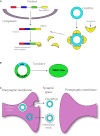Epigenetics in Neurodevelopment: Emerging Role of Circular RNA
- PMID: 31379511
- PMCID: PMC6658887
- DOI: 10.3389/fncel.2019.00327
Epigenetics in Neurodevelopment: Emerging Role of Circular RNA
Abstract
Canonical epigenetic modifications, including DNA methylation, histone modification and chromatin remodeling, play a role in numerous life processes, particularly neurodevelopment. Epigenetics explains the development of cells in an organism with the same DNA sequence into different cell types with various functions. However, previous studies on epigenetics have only focused on the chromatin level. Recently, epigenetic modifications of RNA, which mainly include 6-methyladenosine (m6A), pseudouridine, 5-methylcytidine (m5C), inosine (I), 2'-O-ribosemethylation, and 1-methyladenosine (m1A), have gained increasing attention. Circular RNAs (circRNAs), which are a type of non-coding RNA without a 5' cap or 3' poly (A) tail, are abundantly found in the brain and might respond to and regulate synaptic function. Also, circRNAs have various functions, such as microRNA sponge, regulation of gene transcription and interaction with RNA binding protein. In addition, circRNAs are methylated by N 6-methyladenosine (m6A). In this review, we discuss the crucial roles of epigenetic modifications of circRNAs, such as m6A, in the genesis and development of neurons and in synaptic function and plasticity. Thus, this type of changes in circRNAs might be a therapeutic target in central nervous system (CNS) disorders and could aid the diagnosis and treatment of these disorders.
Keywords: circular RNA; epigenomics; m6A; neurodevelopment; non-coding RNA.
Figures



Similar articles
-
Epigenetic modifications in acute myeloid leukemia: The emerging role of circular RNAs (Review).Int J Oncol. 2021 Dec;59(6):107. doi: 10.3892/ijo.2021.5287. Epub 2021 Nov 18. Int J Oncol. 2021. PMID: 34792180 Free PMC article. Review.
-
N6-Methyladenosine Modification Opens a New Chapter in Circular RNA Biology.Front Cell Dev Biol. 2021 Jul 23;9:709299. doi: 10.3389/fcell.2021.709299. eCollection 2021. Front Cell Dev Biol. 2021. PMID: 34368159 Free PMC article. Review.
-
Recent advances in crosstalk between N6-methyladenosine (m6A) modification and circular RNAs in cancer.Mol Ther Nucleic Acids. 2022 Jan 21;27:947-955. doi: 10.1016/j.omtn.2022.01.013. eCollection 2022 Mar 8. Mol Ther Nucleic Acids. 2022. PMID: 35211355 Free PMC article. Review.
-
Novel insights into the interaction between N6-methyladenosine modification and circular RNA.Mol Ther Nucleic Acids. 2022 Jan 10;27:824-837. doi: 10.1016/j.omtn.2022.01.007. eCollection 2022 Mar 8. Mol Ther Nucleic Acids. 2022. PMID: 35141044 Free PMC article. Review.
-
The m6A-epitranscriptomic signature in neurobiology: from neurodevelopment to brain plasticity.J Neurochem. 2018 Oct;147(2):137-152. doi: 10.1111/jnc.14481. Epub 2018 Aug 1. J Neurochem. 2018. PMID: 29873074 Review.
Cited by
-
Identification of RNA: 5-Methylcytosine Methyltransferases-Related Signature for Predicting Prognosis in Glioma.Front Oncol. 2020 Aug 19;10:1119. doi: 10.3389/fonc.2020.01119. eCollection 2020. Front Oncol. 2020. PMID: 32974125 Free PMC article.
-
MicroRNAs serve as prediction and treatment-response biomarkers of attention-deficit/hyperactivity disorder and promote the differentiation of neuronal cells by repressing the apoptosis pathway.Transl Psychiatry. 2022 Feb 19;12(1):67. doi: 10.1038/s41398-022-01832-1. Transl Psychiatry. 2022. PMID: 35184133 Free PMC article.
-
Differential expression of circular RNA in patients with white matter hyperintensity and cognitive impairment.Zhong Nan Da Xue Xue Bao Yi Xue Ban. 2021 Oct 28;46(10):1080-1089. doi: 10.11817/j.issn.1672-7347.2021.200692. Zhong Nan Da Xue Xue Bao Yi Xue Ban. 2021. PMID: 34911837 Free PMC article. Chinese, English.
-
Downregulation of hsa_circ_0001836 Induces Pyroptosis Cell Death in Glioma Cells via Epigenetically Upregulating NLRP1.Front Oncol. 2021 Mar 31;11:622727. doi: 10.3389/fonc.2021.622727. eCollection 2021. Front Oncol. 2021. Retraction in: Front Oncol. 2021 Dec 29;11:840877. doi: 10.3389/fonc.2021.840877. PMID: 33869006 Free PMC article. Retracted.
-
Identification and characterization of N6-methyladenosine circular RNAs in the spinal cord of morphine-tolerant rats.Front Neurosci. 2022 Aug 5;16:967768. doi: 10.3389/fnins.2022.967768. eCollection 2022. Front Neurosci. 2022. PMID: 35992914 Free PMC article.
References
Publication types
LinkOut - more resources
Full Text Sources
Miscellaneous

